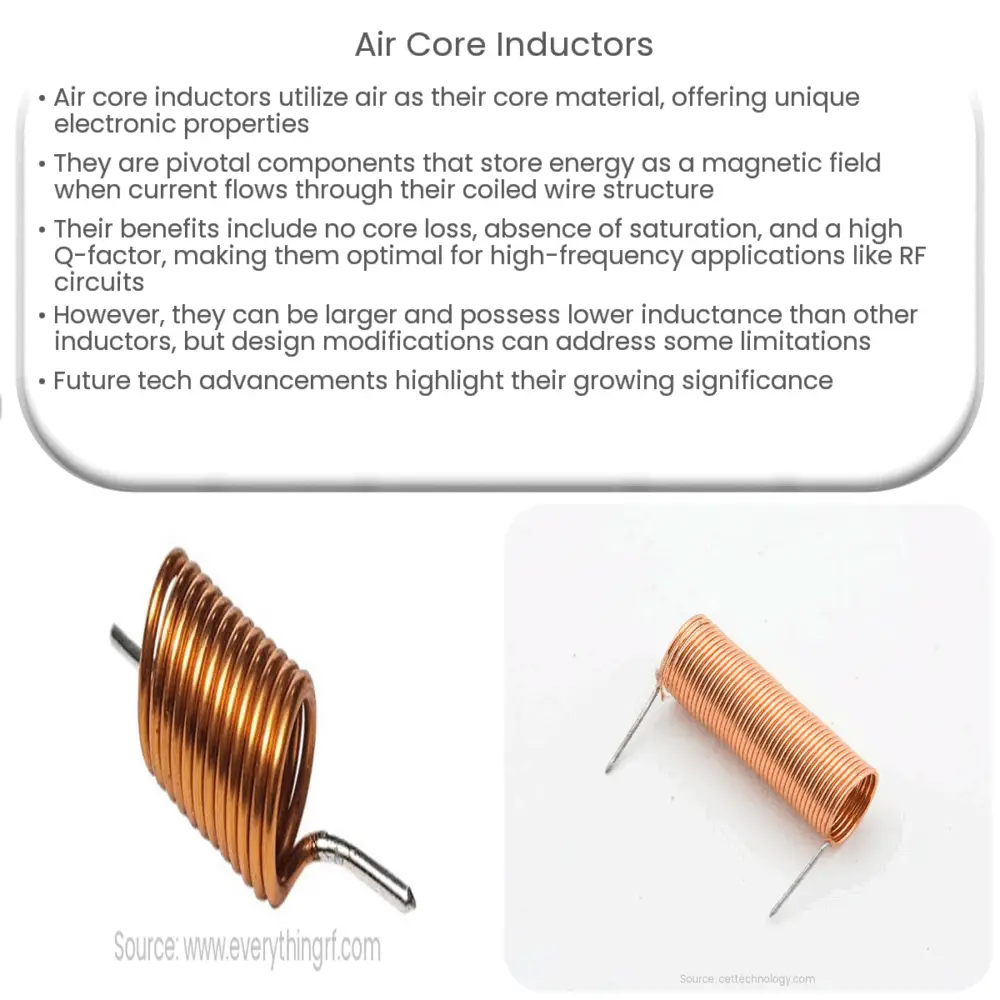Explore the world of air core inductors, their unique properties, and applications in high-frequency electronics. Uncover the future perspectives in this field.

A Deep Dive into Air Core Inductors
Understanding the function and application of air core inductors can be pivotal in many engineering, technology, and electronics contexts. To simplify, an air core inductor is a type of inductor that uses air as its core material. While it may seem basic, this component plays a significant role in the electronic world due to its unique properties and wide range of applications.
The Basics: What is an Inductor?
To fully grasp the concept of air core inductors, it is crucial to first understand the fundamental concept of an inductor. In the simplest terms, an inductor is an essential electronic component that stores energy in the form of a magnetic field. It does this when an electrical current passes through it. In its most basic form, an inductor is typically a coil of wire.
Core Material: The Air Factor
While the ‘wire coil’ setup is a standard feature of all inductors, the core around which the coil is wound varies significantly. This core material is often a crucial determinant of the inductor’s overall characteristics. In the case of air core inductors, as the name suggests, the core is simply air.
Properties of Air Core Inductors
- No Core Loss: Since there is no solid core material, air core inductors have no core loss. This is a considerable advantage over inductors with ferromagnetic cores, which suffer from core losses due to hysteresis and eddy currents.
- No Saturation: The air core inductor doesn’t have a saturation point, another advantage over ferromagnetic-core inductors. Saturation can limit the inductor’s performance at high current levels.
- High-Q Factor: Air core inductors have a high quality factor (Q), implying a lower rate of energy loss. This property makes them ideal for high-frequency applications.
Applications of Air Core Inductors
Due to their unique properties, air core inductors find applications in a variety of areas. Notably, they are used extensively in high-frequency applications such as radio frequency (RF) circuits, tuners, and antenna systems. In such settings, their lack of core loss and high Q factor are immensely valuable.
Air Core Inductors Vs. Other Inductor Types
While air core inductors bring unique benefits, they also have limitations, especially when compared to other types of inductors. For instance, they typically have lower inductance values and can be larger and heavier for the same inductance level as their counterparts.
Despite these limitations, the choice of inductor is always a balance between the specific application requirements and the characteristics of the inductor. This is where the air core inductor often shines.
Design and Construction of Air Core Inductors
The construction of an air core inductor is relatively simple, yet it requires precision and attention to detail. It typically consists of a coil of wire wound around a non-magnetic form, often made of plastic or other materials. The wire gauge, the number of turns, and the diameter of the coil play a significant role in determining the inductor’s inductance value.
While designing and constructing an air core inductor, it’s essential to consider the factors that affect its performance, including the coil diameter, the coil length, the number of turns, and the spacing between the turns. Each of these factors can significantly influence the inductance and Q factor of the inductor.
Overcoming Limitations: Air Core Inductors in Practice
While air core inductors have some inherent limitations, such as relatively lower inductance and larger physical size for the same inductance level, these can often be overcome through careful design. For example, increasing the number of turns or using a larger diameter coil can enhance the inductance. However, these changes could affect other aspects like the Q factor, so it’s a matter of finding the right balance for the specific application.
Future Perspectives
With the rapid advancements in technology and the increasing demand for high-frequency applications, the importance of air core inductors is expected to grow. Their ability to function optimally at high frequencies, combined with the absence of core loss and saturation, makes them a critical component in next-generation electronics.
Conclusion
In conclusion, air core inductors, with their unique properties and applications, hold a significant place in the world of electronics. Despite their limitations, their performance in high-frequency applications is unparalleled. By understanding their fundamentals and applications, one can harness their potential effectively.
As technology continues to evolve, the relevance and importance of air core inductors are likely to increase. With ongoing research and development, it is possible that we might witness new variations of these inductors, tailored to meet the ever-evolving needs of the electronic world. Thus, it’s safe to say that the journey of air core inductors is far from over, and they will continue to be a cornerstone in the field of electronics.

